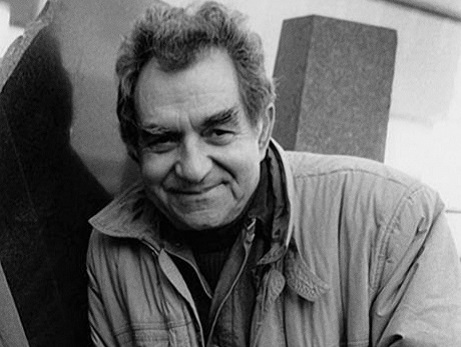Biography
Dimitri Hadzi was born into a poor immigrant family in 1921 in the Greenwich Village section of New York City. He was “always interested in art,” and at the age of twelve won a medal for his drawings. His mother, who was educated, encouraged him to major in art. His father and an uncle played musical instruments. Hadzi has said that his father's manual dextrin, acquired as a result of his work in the fur business, made a significant impact on him. His introduction to tools came from an uncle who was an amateur painter and a skilled craftsman.
The family business failed during the Depression, and they had to move frequently. Hadzi learned the fundamentals of chemistry in high school and then worked as an assistant in a research laboratory for three years (studying chemistry at night), until the United States entered World War II. He became a radio mechanic in the army. While stationed “on an 8-square-mile island in the South Pacific,” his interest in art was reawakened by a colonel who recognized his talent and “pushed him into making drawings of army life.”
After being discharged from the Army, Hadzi hitchhiked home across the country, “visiting museums all the way” and learning to understand and love the work of Henry Moore and the Cubists. In New York he studied at the Cooper Union at night, later adding day classes at the Brooklyn Museum Art School while working eighteen hours a day on weekends. In 1950 Hadzi went to Greece on a Fulbright to study stone carving at the Athens Polytechneion: “The discipline of having to copy something and to understand it … was good for training the eye, the hand, and also for learning the craft.” Even though travel was limited just after Greece's civil war had ended, he was able to visit sites in Turkey, Egypt, and, finally, Rome, where he settled under the G.I. Bill to study and work at his art.
Over time, Hadzi's work became more experimental, exploring both exterior and interior space. The large bronze Ê458 The Hunt (1966) was commissioned for Avery Fisher Hall at Lincoln Center and named for a Mozart string quartet that “suggested the chase of animals and flight of birds“'; the work demands that one walk into it and look up through its branching forms. This was preceded and followed by other public commissions, including: Floating Helmets (1963-65), with its possible tragic allusions to World War II and the Vietnam War, purchased by the Yale Art Galley; the basalt “standing stones” of the River Legend (1976), for the Federal Office Building in Portland, Oregon; Propylaea (1982), the three-story-high granite fountain gate in the Maumee River at Toledo; and many other works. Hadzi, who returned from Rome in 1989 to become Professor of Art at Harvard University, is one of the most influential sculptors of public works in the United States today.
“The whole idea of coming out of that tradition [of ancient Greek art] was very inspiring to me. It brings you down on your knees. I use it as an inspiration.“
Dimitri Hadzi’s biography is sourced from the catalogue of the exhibition Modern odysseys: Greek American artists of the 20th century (Selz, Peter, and William R. Valerio. 1999. Queens, N.Y.: Queens Museum of Art.)



